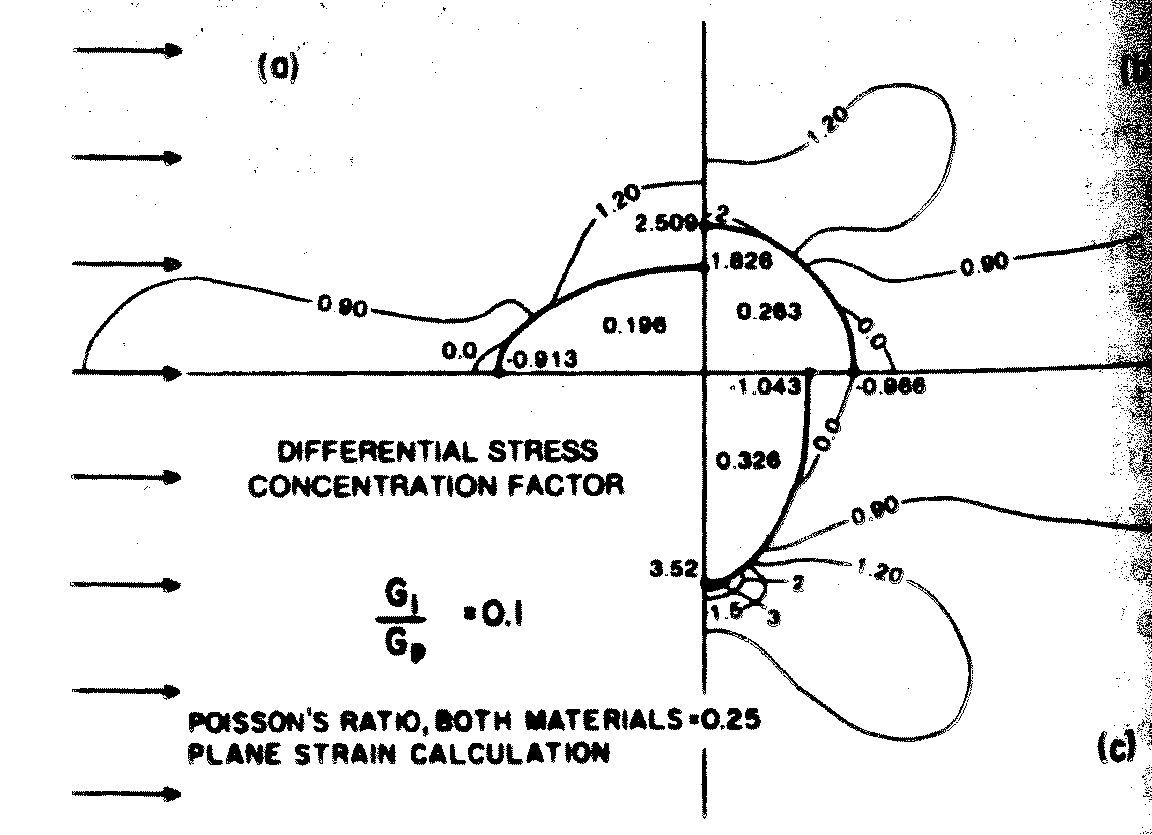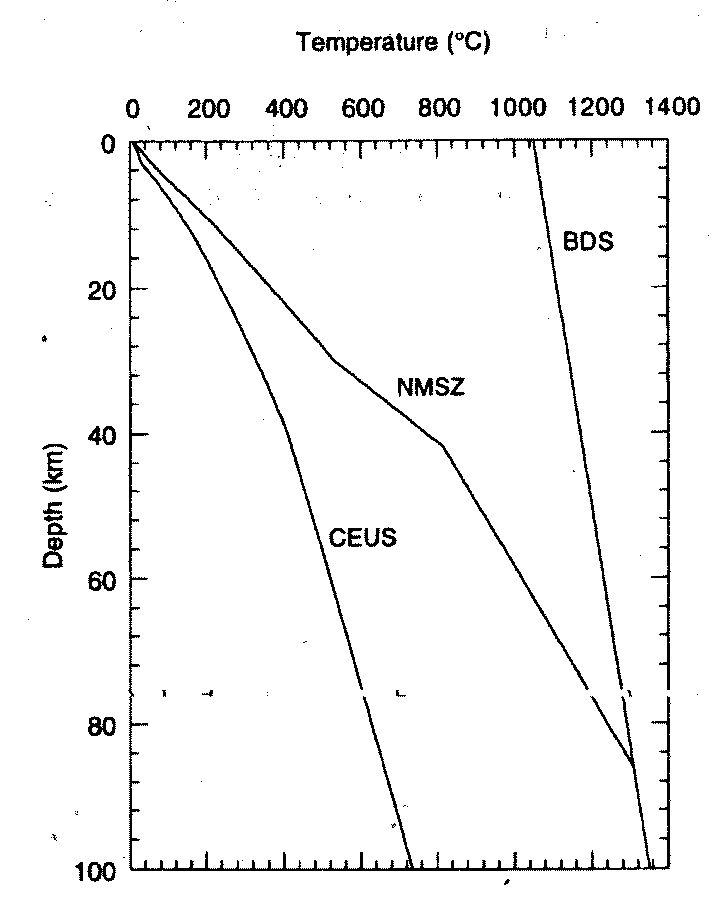
Matt Fillingim
GPHYS 502
Final Paper

Figure 1 (From Hinze et al. [1988])
However, this is not to say that intraplate earthquakes do not pose a significant hazard. For example, in the winter of 1811-1812, over the period of a few months, three earthquakes with estimated moment magnitudes, MW, greater than 8.0 decimated New Madrid, Missouri. In 1886 an earthquake with an estimated MW of 7.6 occurred in Charleston, South Carolina. These earthquakes caused widespread damage not only because they were large, but also because the rigid continental crust of plate interiors transmits seismic energy more efficiently than the heavily fractured crust near plate boundaries. The New Madrid earthquakes damaged buildings as far as 1000 miles away on the East Coast [Johnston and Kanter, 1990].
From crustal deformation rates and from paleoseismic studies [Johnston and Kanter, 1990; Liu and Zoback, 1997], the recurrence time for such large intraplate earthquakes is expected to be on the order of thousands of years. Because of this long recurrence time, major earthquakes may occur in areas that have been historically seismically inactive, particularly in North and South America where written records are at most half the estimated recurrence time. Being able to identify areas at risk for major intraplate earthquakes is, therefore, very important. To understand where intraplate earthquakes might occur, it is necessary to have an idea about the mechanism that causes them. There are three main groups of theories that have been proposed to explain the spatial occurrence of intraplate earthquakes: stress concentration, zone of weakness, and high heat flow.
When a magmatic intrusion is present in stable rock, the difference in geophysical properties can cause localized stress concentrations, particularly when the intrusion is weaker than the surrounding rock. The basis for this theory is as follows: a mafic intrusion can be injected into the mostly felsic continental crust. Initially, the mafic intrusion is more rigid than the surrounding crust. Over time, however, the intrusion can become serpentinized and become much weaker than the surrounding rock. Calculations have shown that intrusions with very sharp edges, i.e., small radii of curvature, can increase the shear stress in the surrounding rock by nearly nine times [Campbell, 1978].
Figure 2 shows the results of a model calculation by Campbell [1978]. In this model, the intrusion was supposed to have a rigidity of 0.1 times that of the surrounding crust. A uniform horizontal compressive stress was applied. Quadrants (a), (b), and (c) show the results for an elliptical intrusion with an ellipticity of 2 with the major axis parallel to the direction of maximum compressive stress, a circular intrusion, and an elliptical intrusion with the major axis perpendicular to the direction of maximum compressive stress, respectively. The curves show contours of the increase in maximum shear stress and are symmetric about both axes in all three cases. The maximum increase in shear stress occurs in case (c) near the ends of the ellipse. Also note that negative numbers indicate regions in tension. The largest negative values also occur in case (c).

Figure 2 (From Campbell [1978])
Near New Madrid, there is gravity and magnetic evidence for a large mafic intrusion, known as the Bloomfield pluton, about 10 km from a line of earthquake epicenters [Kane, 1977]. The close proximity of this pluton to areas of active seismicity suggest a cause and effect relationship. Also, evidence has been found for a large mafic or ultramafic intrusion near the site of the Charleston, SC, earthquake [Long and Champion, 1977].
However, Ravat et al. [1987] have modeled the effect of the Bloomfield pluton on the region around New Madrid. Their results indicate that seismicity in the area is not related to the presence of the pluton and that stress concentration is not the cause of earthquakes near New Madrid. Additionally, critics of this theory point out that such intrusions are quite localized, and as such, potential earthquake areas associated with intrusions are small. The activity due to this mechanism, then, is expected to be minor and of low energy [Hinze et al., 1988].
Figure 3 illustrates how this mechanism works. (1) Extensional stress, due perhaps to upwelling magma beneath the region, can deform the crust and create faults. (2) After the extensional stress ceases, the weakened crust is covered with sediment over millions of years. (3) Once this area is again subjected to tectonic stresses, the ancient faults can be reactivated. Johnston and Kanter [1990] found that 49 % of all intraplate earthquakes occur near ancient failed rifts or passive margins even though only one quarter of all stable continental crust is of this type. Additionally, 60 % of intraplate earthquakes with MW > 6 and 100 % of intraplate earthquakes with MW > 7 have occurred near previously extended crust.

Figure 3 (From Johnston and Kanter [1990])
The New Madrid Seismic Zone (NMSZ) lies directly above an ancient failed rift, the Reelfoot rift. About 550 million years ago, a rift began to form under the present day site of New Madrid [Vogel, 1996]. For unknown reasons, the rift failed and subsequently became filled with sediment. Similarly, 180 million years ago, as the Atlantic Ocean began to open, a rift developed near present day Charleston. This rift was successful. Over the next 180 million years, the margin of continental North America moved thousands of kilometers away from the spreading center, but the crust around Charleston, known as a passive margin, remains faulted [Johnston and Kanter, 1990].
However, there are areas of continental crust which have been fractured in the past and are now subject to compressive stresses which are not presently tectonically active [Vogel, 1996]. Also, moderate size intraplate earthquakes have been observed in regions where the crust had not been deformed in the past, for example in western and central Australia [Johnston and Kanter, 1990]. Finally, it appears as though areas which are presently active have not always been active through geologic time. Regional strain rates in the NMSZ are on the order of 10-15 s-1, about three orders of magnitude higher than the strain rates in the surrounding regions [Liu et al., 1992]. If stresses have been acting on this area for the past 180 million years, then the expected total strain accumulation is one the order of a few hundred percent. These discrepancies have prompted the search for other factors which control what intraplate areas are seismically active.

Figure 4 (From Liu and Zoback [1997])
Assuming typical crustal and upper mantle compositions, Liu and Zoback [1997] calculated the cumulative lithospheric strength. In the area of the NMSZ, the cumulative lithospheric strength (~4 X 1012 N/m) is on the order of the tectonic forces acting on the lithosphere imposed by the plate margins, 2 to 5 X 102 N/m. The large temperature at depth weakens the upper mantle and lower crust, leaving the upper crust to support the far field stresses. Since the strength of the upper crust is comparable to the plate driving forces, the lithosphere in this area can experience significant deformation. In surrounding areas where the temperature is cooler, the cumulative strength of the lithosphere is between 20 and 60 X 1012 N/m, an order of magnitude greater than the ridge push forces. In these regions, the rigid lower crust and upper-most mantle support most of the tectonic stresses and no lithospheric deformation is predicted.
| Model | Pro | Con |
|---|---|---|
| Stress Concentration | Spatial correlations of earthquake epicenters and geophysical anomalies | Inhomogeneities are localized; only minor earthquakes are expected |
| Zone of Weakness | Excellent correlation with large intraplate earthquakes | Some ancient faults are not active; some active areas are not near ancient extended regions |
| High Heat Flow | Appears to work well for New Madrid seismic zone | Model has not been applied to any other seismically active region; Is high heat flow present at all intraplate earthquakes? |
As for nearly everything in nature, there is probably not just one single cause for all intraplate earthquakes. Some combination of the present theories and some as yet undiscovered ones is more likely the explanation. The question may be which mechanism is dominant, and the question's answer may vary from place to place. Finally, none of these models appears to explain the lack of cumulative deformation in seismically active intraplate areas. It has been proposed that some other mechanism turns on and off areas of intraplate seismicity so that large scale deformations do not take place over geologic time [Vogel, 1996]. However, what this mechanism may be is still an open question.
Hinze, W. J., L. W. Braile, G. R. Keller, and E. G. Lidiak, Models for midcontinent tectonism: An update, Rev. Geophys., 26, 699-717, 1988.
Johnston, A. C., and L. R. Kanter, Earthquakes in stable continental crust, Sci. Am., 262(3), 68-75, 1990.
Kane, M. F., Correlation of major eastern earthquake centers with mafic/ultramafic basement masses, U.S. Geol. Surv. Prof. Pap., 1028-O, 1977.
Liu, L., and M. D. Zoback, Lithospheric strength and intraplate seismicity in the New Madrid seismic zone, Tectonics, 16, 585-595, 1997.
Liu, L., M. D. Zoback and P. Segall, Rapid intraplate strain accumulation in the New Madrid seismic zone, Science, 257, 1666-1669, 1992.
Long, L. T. and J. W. Champion, Bouguer gravity map of the Summerville-Charleston, South Carolina, epicentral zone and tectonic implications, U.S. Geol. Surv. Prof. Pap., 1028-K, 1977.
Ravat, D. N., L. W. Braile, and W. J. Hinze, Earthquakes and plutons in the midcontinent - evidence from the Bloomfield Pluton, New Madrid rift complex, Seismol. Res. Lett., 58, 41-52, 1987.
Sbar, M. L. and L. R. Sykes, Contemporary compressive stress and seismicity in eastern North America: An example of intra-plate tectonics, Geol. Soc. Am. Bull., 84, 1861-1882, 1973.
Sykes, L. R., Intraplate seismicity, reactivation of preexisting zones of weakness, alkaline magmatism, and other tectonism postdating continental fragmentation, Rev. Geophys., 16, 621-688, 1978.
Vogel, S., Naked Earth: The New Geophysics, Penguin Group Books, New York, 1996.